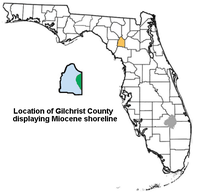Thomas Farm Site

Gilchrist County, Florida and Miocene shoreline based on the Florida Geologic Survey.

Florida during the Miocene
The Thomas Farm site is an Early Miocene, Hemingfordian assemblage of vertebrate fossils located in Gilchrist County, northern Florida.
The Thomas Farm site is one of the richest terrestrial deposits of Miocene vertebrates in the 18 Ma range found in eastern North America according to the Florida Museum of Natural History. The site was discovered in 1931 by Florida Geological Survey (FGS) staff member Clarence Simpson.[1] Specimens include: amphibians, reptiles, birds, small rodents, bats, rhinoceroses, three species of three-toed horses, several artiodactyls (including camels, peccary, deer-like species and other extinct forms), as well as dogs, bears, and bear-dogs.
Specimens
Reptilia
- Pseudemys
- Testudo (T. tedwhitei)
- Phalacrocorax (P. subvolans)
- Promilio (P. epileus)
- Promilio (P. brodkorbi)
- Proictinia (P. floridana)
- Alligator (A. olseni)
- Paraoxybelis (P. floridanus)
- Pseudocemophora (P. antiqua)
- Anilioides (A. minuatus)
- Pseudoepicrates (P. stanolseni)
- Ogmophis (O. pauperrimus
- Calamagras (C. floridanus)
- Daphoenus (D. caroniavorus)
Birds
Columbidae
Mammals
Rhinocerotidae
- Diceratherium (D. barbouri)
- Floridaceras
Equidae
- Parahippus (P. leonensis)
Amphicyonidae
- Daphoenus (D. caroniavorus
- Anchitherium (A. clarencei)
- Amphicyon (A. longiramus)
- Cynelos (C. caroniavorus)
Ursidae
- Aelurodon (A. johnhenryi)
- Phoberocyon (johnhenryi)
Mustelidae
- Mephitaxus (M. ancipidens)
- Miomustela
- Zodiolestes (Z. freundi)
- Oligobunis (O. floridanus)
Canidae
- Osbornodon iamonensis
- Euoplocyon (E. spissidens)
- Metatomarctus (M. canavus)
- Aelurocyon (A. spissidens
- Phlaocyon
Chiroptera
- Chiroptera sp.
- Primonatalus (P. prattae)
- Karstala (K. silva)
- Miomyotis (M. floridanus)
- Svaptenos (S. whitei)
Artiodactyla
- Floridachoerus (F. olseni)
- Machaeromeryx (M. gilchristensis)
- Parablastomeryx (P. floridanus)
- Merycoidodon
- Syndyoceras (S. australis)
- Floridatragulus (F. dolichanthereus)
- Oxydactylus (O. floridanus)
- Nothokemas (N. floridanus)
Soricidae
- Limnoecus
Rodentia
- Cricetidae
- Proheteromys (P. magnus)
- Proheteromys P. floridanus)
- Miospermophilus
- Nototamias (N. hulberti)
- Petauristodon (P. pattersoni)
- Mesogaulus
- Mylagaulidae
Amphibians
- Proacris (P. mintoni)
- Proacris mintoni
References
This article is issued from
Wikipedia.
The text is licensed under Creative Commons - Attribution - Sharealike.
Additional terms may apply for the media files.